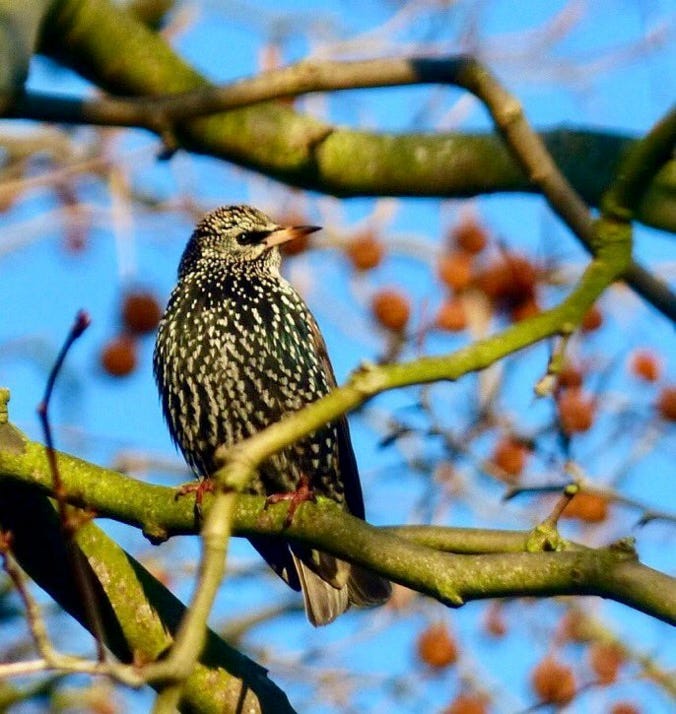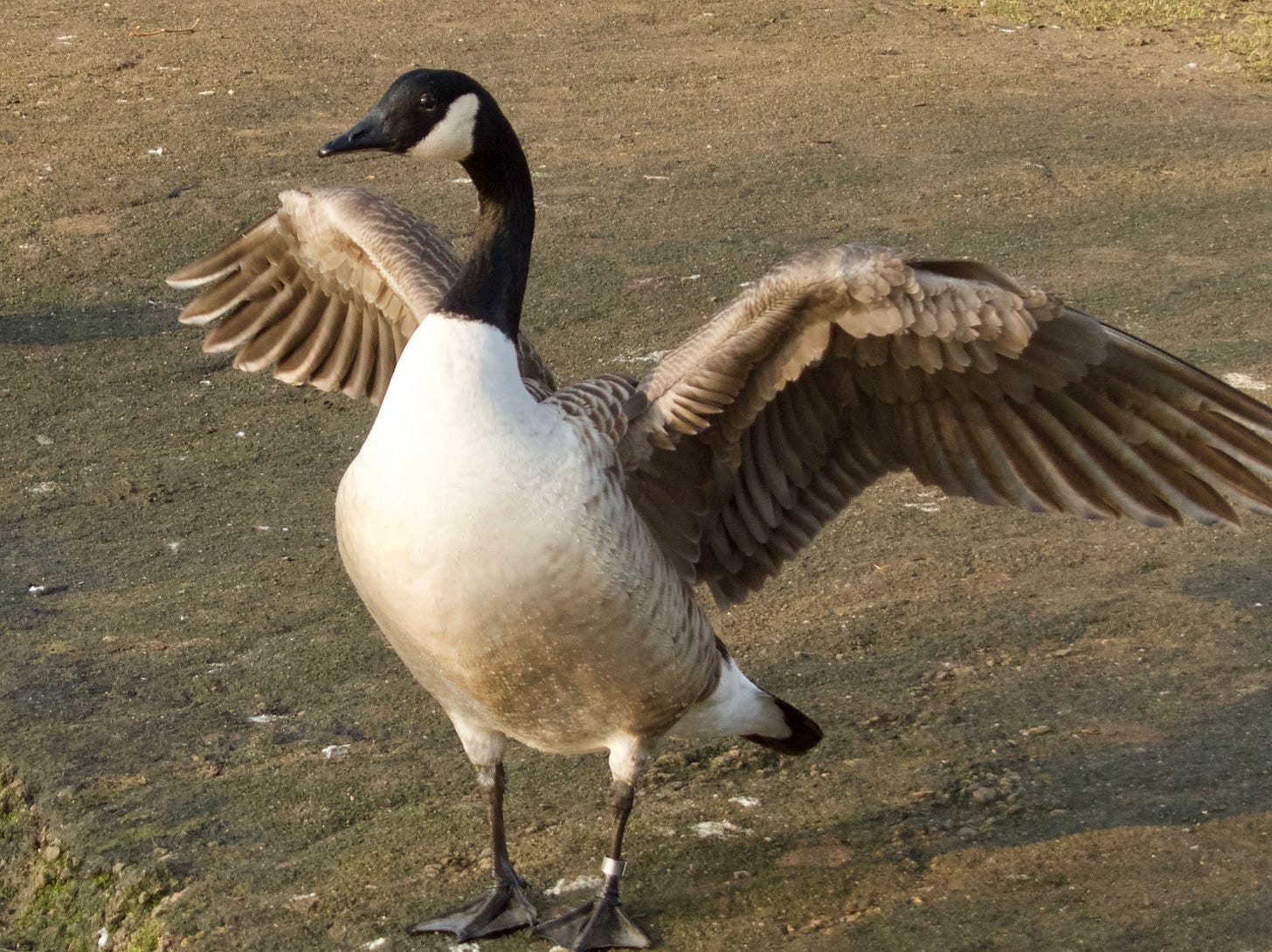Hello. Welcome. Thanks for being here.
Every week in 2025, as well as the regular Six Things posts, I’ll be writing about birds. If birds aren’t your thing, perhaps I can lure you into their evil world. And if no absolutely not, then you can always toggle your preferences so you only get what you want.
For those who stay, there will be:
– a bit about my birding activities that week
– micro-essays about two British birds
– a couple of news-y or science-y or otherwise of interest bits from elsewhere
I hope you enjoy it all.
The Joy of Drumming
A dark day, the mood reflected in the weather. The word “aagghh” lurks constantly near the surface. So too the words “fucking hell, he did WHAT?”
News off. Binoculars. Walk.
I’m getting used to the somewhat tedious fact that exercise is good for you. So annoying, so easily forgotten. Brisk movement, heart rate up, endorphins fizzing.
Also good for me is the jay. The jay knows nothing of human emotions, is entirely oblivious to the joy I feel at the sight of its peachy body, white rump, greasepaint moustache and trademark turquoise wing flash. All it knows, as far as I can tell from its behaviour, is that it hid an acorn in one of the crevices of this plane tree six months ago, and now it can’t find it. It pokes. It prods. It has a good old furtle. But acorns there are none.
It flies away, carrying with it a faint air of exasperation. Its next act will presumably be to launch a wide-ranging enquiry into the acorn’s disappearance, the finger of suspicion hovering with grim inevitability over the head of that squirrel, you know the one, the acorn-thieving shit.
Two trees down, another movement, as of a smaller, nimbler thing. Black and white, red undercrackers.
Great spotted woodpecker. Yes. Hello.
It scuttles to the end of a bare branch, picks its spot and lets rip, head and beak moving too fast to track.
Ddddrrrrrrr.
Yes. YES.
A drumming woodpecker is a Great January Thing, an early signifier that we’re rounding the final arc of the endless curve towards spring. Antidote to aagghh.
I’m sometimes asked a straightforward question. “Why birds?”
I could give the simple, childlike answer, channelling Arthur Shappey. “Birds are BRILLIANT!”
Or I could point to the jay and the woodpecker with a shrug, as if to say “I mean, just look at them.”
But if forced to give a bit more detail, I would always default to this.
“A day with a bird in it is better than a day without.”
Simple. Classic. And I’ve never known it to be wrong.
Common Starling
These birds, these amazing birds. Where to start?
Murmurations, perhaps – those shapeshifting clouds, constant flux of feather and wing and bone, their screensaver fluidity accompanied by the soft rushing murmur of wings – many, many wings – through air. How fortunate for us that this behaviour – thought to be protection against predators – is so mesmerising to humans when viewed from the outside, those billowing shapes pressing little pleasure buttons in our brains. Quite the event they are these days. A highlight of winter, eliciting gasps of awe from those who have gathered to witness one of the great natural spectacles. And quite right too. To be indifferent to a murmuration is to be dead in all but name.
Or how about their song? Catch a starling alone, perhaps giving its recital perched on a TV aerial above your local kebab shop, and you might be treated to a series of impersonations, their talent for sound reproduction as highly evolved as in any other bird. Trimphones were their speciality, back in the day. Nowadays they’ll do a mean car alarm, as well as running the gamut of their fellow avians, from blackbird to zitting cisticola. Put a group of them together and you get an electric chatter of squeaks and whistles, like someone trying to tune a short wave radio.
Or you can just revel in their plumage – glossy black flashing iridescent green-purple in the low winter sun, creamy arrowhead spots on the chest offset by the pale yellow of the sharp bill.
I am of course blinded by love. Alan Bennett sees them differently.
“Slightly sweaty birds … They have the look of a threadbare maitre d’ who hangs up his tailcoat shiny with age in his cheap lodgings every night. Cocky, too, of course, a thumbs-in-the-lapels sort of bird.”
I can’t disagree. But I can’t quite agree either.
A scene. An urban street. Winter. The whirr of wings overhead. I look up just in time to see fifty starlings whizzing past. Two of them tumble out of the group with a flurry of squawking, like a pub brawl spilling out onto the street.
“Clipped my wing, you cunt.’
“Fuck off.”
“Come and have a go.”
“Shit, wait, where is everyone?”
And just like that, differences resolved, they scramble back into the fold.
ID: blackish but with glossy green-blue sheen; creamy speckling in autumn and winter; triangular shape in flight.
Where: almost anywhere; feeds in grassy areas; habitué of town centres, farms, countryside and much more.
Sounds: ooh, loads of them
Further reading:
Giorgio Parisi – In a Flight of Starlings
Canada Goose
I have a soft spot for this much maligned goose. Are they beautiful? Not especially. Elegant? Only if you squint. But they were, for me, a gateway back to birds. It was a flock of Canada geese in my local park that cemented the return of my childhood passion for birds about a decade ago. From flirtation to obsession, in the time it took for them to fly over my head.
Here’s how I wrote about that life-changing minute in Why Do Birds Suddenly Disappear?
I stride through the park gates, listening to a fascinating podcast about Thucydides, the details of which will leave my head fifteen seconds after it’s finished. Sun. Sky. Frost. I ponder nothing more urgent than whether to take the left or right fork to skirt the boating lake.
A brouhaha from behind the trees makes the decision for me.
Eight Canada geese in a mood to party are difficult to ignore. I hear them clamouring, cackling, honking. This is what they’re known for. Noise and poo and general unpleasantness.
Their ubiquity, dominance and brazenness combine to make them almost universally unpopular among those who frequent public spaces. Shit-squirters, honking bullies, bastards.
I get all that.
But as I turn the corner and the lake comes into view, they’re a magnificent sight. A squadron of eight birds, organising themselves into formation, calling to each other in fervid excitement, a frenzy of organised chaos coming together at the last second as the final goose slots into place. They churn the water and the air, sending their fellow waterfowl scuttling for cover.
They come right at me, wings straining, so low I could almost reach out and touch their undercarriage. The air is full of their honking and flapping, the geometry of their formation kaleidoscoping – Escher brought to life as they heave themselves up. The displaced air wafts over me, a reminder of the weight and difficulty of flight.
As they deliver noisy chaos to another part of genteel Dulwich, I’m struck by the everyday beauty of the spectacle. A common bird flying from one place to another in a group. It’s what they do. Maybe it’s just the thrill of that movement and noise so close above me that stirs the blood. Or the timing of it, as if they were calling to me from behind the trees and assembled for my benefit, knowing the pram-pushers and mutt-draggers would dismiss them as mere background to modern city life. Maybe I’m just in a heightened state of post-yoga awareness, liable to wonder at anything. Hello birds, hello sky.
Whatever, they stay with me all the way home, those geese, the images of that magical minute looping in the cinema of my mind. And they trigger something, a long-forgotten interest, ahidden memory buried deep under three decades of other stuff. There have been moments when it’s resurfaced, but they’ve been fleeting. Noticing the swifts’ return every year; getting and filling a bird feeder when we moved and acquired an accessible garden; rescuing a live woodpigeon from the jaws of the cat. But for each flicker of interest there’s been a subconscious tamping down, as if to say, “That’s enough now. You’re too busy for such fripperies.”
Now it comes surging to the surface, elbowing other thoughts aside. On the way home I not only notice the birds, I seek them out. There’s another little park over the road. Why not go that way? Perhaps there’ll be a moorhen or two. And sure enough, there they are, black corks bobbing on the water, distinguished from their coot cousins by the red blob on their forehead.
And that little ball of fluff on an ice-lolly stick. Long-tailed tit, no? Yes? No? Not sure. Not a wagtail. Too small. Sweet little thing, anyway.
A blackbird on the grass, head cocked, listening out for the movement of a worm. Robins, blue tits, great tits, magpies, crows, pigeons. The air is suddenly thick with them. Where have they been all these years?
I go home and revisit my past.
So there you go. You can buy a signed copy of Why Do Birds Suddenly Disappear? from me here, or an unsigned one from bookshop.org here. Please note that I can only send to the UK. If you live elsewhere, your best option might be Blackwell’s, who I think deliver cheaply abroad.
ID: stocky, large, brown; white chest, black neck and head with white patch on face.
Where: urban parks, lowland lakes, reservoirs, gravel pits etc.
Sounds: honk.
Further reading:
Nick Acheson – The Meaning of Geese
Magic
Fascinated by this article on performing close-up magic to birds.
Sculpture
And these digital sculptures – visualisations of bird sounds – by Andy Thomas are amazing.






Nah the like button doesn’t cut it for this. LOVE.
I absolutely love your writing, including any words you choose or deem appropriate. I used to feed my garden birds but the food invariably attracts vermin. So I stopped. Aaaaaarrrrgh 👀😁